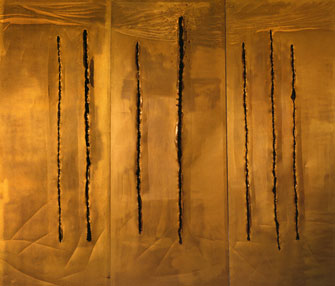Homage to the Man
Who Invented Attack Art

“Concetto Spaziale, New York 10” (1962) © Fondazione Lucio Fontana, Milano/by SIAE/Adagp, Paris 2014
For two decades after World War I, Lucio Fontana was, literally, at the cutting edge of Italian contemporary art. Where other artists might use a palette knife to smear paint thickly on canvas, Lucio Fontana used a box cutter and spike to slash and stab. A retrospective of his work is showing until August 24 at the Musée d’Art Moderne de la Ville de Paris.
Author of the 1946 “White Manifesto,” the founding doctrine of what became known as the Spatial movement, he was the pivotal theoretician of a concept of art as non-material gesture, an exploration of space freed from the formal conventions and illusory perspectives of classical sculpture and painting. His ideas influenced later developments ranging from Arte Povera to performance art.
Interestingly, the show demonstrates that there was a lot more to him than the ubiquitous slash paintings and perforated canvases for which he is now mostly known – and for which collectors now pay millions.
Raised in a comfortably middle-class Italo-Argentinian family of monument sculptors, Fontana arrived at Spatialism via classical training and forays into Primitivism, Futurism and Abstractionism.
The fruit of intensive research to track down little-known pieces, often in private hands, the show does a good job of repositioning his contribution to postwar conceptualism in the wider context of his artistic origins and trajectory.
The exhibition of some 200 works is organized chronologically from the late 1920s to Fontana’s death in 1968. The prewar figurative work shows an artist in search of a style, with touches of Giacometti, Brancusi, Picasso and Matisse.
The show is particularly strong on his polychrome ceramics – influenced by his early training in the family sculpture business but also by Italian folk art, 18th-century Baroque and Greek classical vases. It also highlights his pioneering experiments with neon light installations.
A structure in neon, like a loosely knotted strand of spaghetti, is the first thing you see at the entrance to the show. Many artists have worked in neon since, but few, if any, before. In this, as in many other media, Fontana was a pathfinder. So too with his polychrome

“Retrato di Teresita” (1940) © Fondazione Lucio Fontana, Milano/by SIAE/Adagp, Paris 2014
ceramics, which break away from any pretense of classicism in their thick, almost grotesque, handling of the clay. They aren’t by any stretch beautiful, but you can sense the texture of the kneaded earth and almost feel the bite of the teeth in his beady-eyed polychrome crocodile (1936-37). Others, like Johan Creten, have gone down that route since, but in 1930s Italy, this was protest art.
The show’s major fault, and it’s a large one, is its silence on the question of Fontana’s social and political allegiances – which is to say, Fascism. It is addressed to some degree in a compendious catalogue but is scarcely visible in the show itself. This is a complex subject, but to ignore it leaves a hole in the narrative.
Fontana fought, was wounded and was decorated for valor as a teenage volunteer in the Italian army in World War I, which was seen by patriotic Italians as a war fought to complete the unification of Italy. In the 1920s and ’30s, he made a living as a sculptor of funerary monuments, exhibited in Fascist exhibitions and sculpted Mussolini.
Was he a nationalist, a fascist or simply living with the reality of the time? The answer may not be clear, but it is a cop-out for the exhibition not to touch on it, given Fontana’s position as an intellectual, philosophical and conceptual artist.
Fontana sat out World War II in Argentina. Returning to Europe when it was over, he found a world in ruins. His Milan studio had been bombed to smithereens. In this obliterated past was an opportunity for a new beginning, and Fontana took it.
For would-be collectors, Tornabuoni Art, a specialist dealer in the Italian Minimalists, is holding a parallel Fontana show in its Avenue Matignon Paris gallery space. Pride of place in the Tornabuoni show goes to “Le Jour,” a perforated painting lost for 30 years and recently rediscovered.
The large gold canvas is particularly rare because its creation in 1962 was documented on film. The video documentary of Fontana’s creative performance can be seen at the gallery and at the museum show.
Musée d’Art Moderne de la Ville de Paris: 11, avenue du Président Wilson, 75116 Paris. Métro: Alma-Marceau or Iéna. Tel.: 01 53 67 40 00. Open Tuesday-Sunday, 10 a.m.-6 p.m. (Thursday until 10 p.m.). Closed on public holidays. Admission: €11. Through Aug. 24, 2014. www.mam.paris.fr
Click here to read all of this week’s new articles on the Paris Update home page.
Reader Reaction: Click here to respond to this article (your response may be published on this page and is subject to editing).
Support Paris Update by ordering books from Paris Update’s Amazon store at no extra cost. Click on your preferred Amazon location: U.K., France, U.S.
© 2014 Paris Update
Favorite
